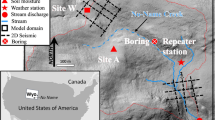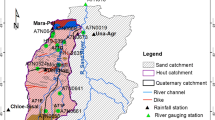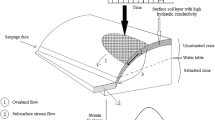Abstract
This paper describes an integrated surface–subsurface modeling study of the Fuxianhu Lake catchment (southwest China). Pollution threats to this important water resource have led to the need to evaluate transport pathways and the overall water balance of the catchment. Catchment inputs to the lake include river inflows, direct overland flow and groundwater discharge, which are incorporated into a mathematical model of the system. Surface runoff and groundwater recharge are estimated using a parsimonious soil–vegetation modeling approach, while groundwater flow is based on the MODFLOW-2005 code. Overland flow and stream discharge are coupled to the groundwater regime through the soil layer and are routed through the catchment to account for surface water flow pathways. The model is tested using the V-catchment benchmark problem and is compared to existing models to demonstrate accuracy and capability. Application of the model to the Fuxianhu catchment provides for the first-order approximation of the average catchment water balance, which comprises such components as evapotranspiration losses (37% of rainfall), surface runoff to the lake (37% of rainfall), and groundwater discharge to the lake (8% of rainfall), amongst others. The computationally efficient approach to surface–subsurface modeling adopted in this investigation presents as an alternative to more complex methods, and allows for the rapid assessment of flow pathways at the catchment scale.
Similar content being viewed by others
References
Abbott MB, Bathurst JC, Cunge JA, O’Connell PE, Rasmussen J (1986) An introduction to the European hydrological system—systeme hydrologique europeen, “SHE”, 2: Structure of a physically-based, distributed modelling system. J Hydrol (Amst) 87(1–2):61–77. doi:10.1016/0022-1694(86)90115-0
Bauer P, Gumbricht T, Kinzelbach W (2006) A regional coupled surface water/groundwater model of the Okavango Delta, Botswana. Water Resour Res 42:W04403. doi:10.1029/2005WR004234
Dang KL, Wang JM (2001) Evaluation on ability of main forest types to store floodwater and prevent flood in subtropic zone of China. J Northwest For Univ 16(1):26–28, 39 (in Chinese)
Freeze RA, Cherry JA (1979) Groundwater. Prentice-Hall, Englewood Cliffs
Harbaugh AW (2005) MODFLOW-2005, the U.S. geological survey modular ground-water model—the ground-water flow process. U.S. Geological Survey Techniques and Methods 6-A16
Heathwaite L, Sharpley A, Bechmann M (2003) The conceptual basis for a decision support framework to assess the risk of phosphorus loss at the field scale across Europe. J Plant Nutr Soil Sci 166(4):447–458. doi:10.1002/jpln.200321154
HydroGeoLogic (1996) MODHMS, a comprehensive MODFLOW-based hydrologic modeling system, version 3.0. HydroGeoLogic, Herndon
Jain MK, Singh VP (2005) DEM-based modelling of surface runoff using diffusion wave equation. J Hydrol (Amst) 302:107–126. doi:10.1016/j.jhydrol.2004.06.042
Jakeman AJ, Letcher RA, Norton JP (2006) Ten iterative steps in development and evaluation of environmental models. Environ Model Softw 21:602–614. doi:10.1016/j.envsoft.2006.01.004
Jiang HK, Gao HY, Zhang Q, Xu LG (2007) Response of water quality to agricultural cultivation in Liangwanghe river catchment of Fuxianhu lake region. Environ Sci 28(10):2294–2300 (in Chinese)
Kollet SJ, Maxwell RM (2006) Integrated surface–groundwater flow modeling: a free-surface overland flow boundary condition in a parallel groundwater flow model. Adv Water Resour 29:945–958. doi:10.1016/j.advwatres.2005.08.006
Krause S, Bronstert A (2007) The impact of groundwater–surface water interactions on the water balance of a mesoscale lowland river catchment in northeastern Germany. Hydrol Process 21:169–184. doi:10.1002/hyp.6182
Liu H-L, Chen X, Bao A-M, Wang L (2007) Investigation of groundwater response to overland flow and topography using a coupled MIKE SHE/MIKE 11 modeling system for an arid watershed. J Hydrol (Amst) 347(3–4):448–459. doi:10.1016/j.jhydrol.2007.09.053
Markstrom SL, Niswonger RG, Regan RS, Prudic DE, Barlow PM (2008) GSFLOW—coupled ground-water and surface-water FLOW model based on the integration of the precipitation-runoff modeling system (PRMS) and the Modular Ground-Water Flow Model (MODFLOW-2005): U.S. Geological Survey Techniques and Methods 6-D1, 240 p
McDonald MG, Harbaugh AW (1988) A modular three-dimensional finite-difference ground-water flow model. U.S. Geological Survey Techniques of Water-Resources Investigations, book 6, chap. A1
McGuire KJ, McDonnell JJ (2006) A review and evaluation of catchment transit time modeling. J Hydrol (Amst) 330(3–4):543–563. doi:10.1016/j.jhydrol.2006.04.020
Nanjing Institute of Geography and Limnology (NIGL) (1990) Fuxianhu lake. Ocean Press, Beijing (in Chinese)
Nastev M, Savard MM, Lapcevic P, Lefebvre R, Martel R (2004) Hydraulic properties and scale effects investigation in regional rock aquifers, south-western Quebec, Canada. Hydrogeol J 12:257–269. doi:10.1007/s10040-004-0340-6
Neitsch SL, Arnold JG, Kiniry JR, Williams JR, King KW (2002) Soil and water assessment tool, theoretical documentation, version 2000. Texas Water Resources Institute, College Station, Texas, TWRI Report TR-191
Niswonger RG, Prudic DE (2006) Documentation of the Streamflow-Routing (SFR2) package to include unsaturated flow beneath streams—a modification to SFR1. U.S. Geological Survey Techniques and Methods, book 6, chap. A13
Panday S, Huyakorn PS (2004) A fully coupled physically-based spatially-distributed model for evaluating surface/subsurface flow. Adv Water Resour 27:361–382. doi:10.1016/j.advwatres.2004.02.016
Prudic DE (1989) Documentation of a computer program to simulate stream–aquifer relations using a modular, finite-difference, ground-water flow model. U.S. Geological Survey Open-File Report 88-729
Prudic DE, Konikow LF, Banta ER (2004) A new stream-flow routing (SFR1) package to simulate stream–aquifer interaction with MODFLOW-2000. U.S. Geological Survey Open-File Report 2004-1042
Rubarenzya MH, Graham D, Feyen J, Willems P, Berlamont J (2007) A site-specific land and water management model in MIKE SHE. Nord Hydrol 38(4–5):333–350. doi:10.2166/nh.2007.016
Sanderson BG, Baginska B (2007) Calculating flow into coastal lakes from water level measurements. Environ Model Softw 22(6):774–786. doi:10.1016/j.envsoft.2006.02.005
Shaman J, Stieglitz M, Engel V, Koster R, Stark C (2002) Representation of subsurface storm flow and a more responsive water table in a TOPMODEL-based hydrology model. Water Resour Res 38(8):1156. doi:10.1029/2001WR000636
Swain ED, Wexler EJ (1996) A coupled surface-water and ground-water flow model (MODBRNCH) for simulation of stream–aquifer interaction: U.S. Geological Survey Techniques of Water-Resources Investigations, book 6, chap. A6, 125 p.
Todini E (1996) The ARNO rainfall-runoff model. J Hydrol (Amst) 175:339–382. doi:10.1016/S0022-1694(96)80016-3
US Army Corps of Engineers (USACE) (2000) Hydrologic modeling system HEC-HMS. Technical Reference Manual, March 2000. Hydrologic Engineering Center, Davis
Wang SM, Dou HS (1998) China lake records. Science Press, Beijing (in Chinese)
Werner AD, Gallagher MR, Weeks SW (2006) Regional-scale, fully coupled modelling of stream–aquifer interaction in a tropical catchment. J Hydrol (Amst) 328:497–510. doi:10.1016/j.jhydrol.2005.12.034
Xu JT, Zhang Q, Xu LG (2007a) Surface runoff modeling of Lake Fuxian catchment. J Lake Sci 19(6):718–726 (in Chinese)
Xu LG, Zhang Q, Li HP, Viney NR, Xu JT, Liu J (2007b) Modeling of surface runoff in Xitiaoxi catchment, China. Water Resour Manage 21(8):1313–1323. doi:10.1007/s11269-006-9083-6
Xu Z, Godrej AN, Grizzard TJ (2007c) The hydrological calibration and validation of a complexly-linked watershed-reservoir model for the Occoquan watershed, Virginia. J Hydrol (Amst) 345:167–183. doi:10.1016/j.jhydrol.2007.07.015
Zhang Q, Xu LG (2005) Observation and modeling of surface and subsurface runoffs for Fuxianhu lake catchment. Sci Technol Eng 5(24):1946–1950 (in Chinese)
Author information
Authors and Affiliations
Corresponding author
Additional information
An erratum to this article can be found at http://dx.doi.org/10.1007/s11269-009-9494-2
Rights and permissions
About this article
Cite this article
Zhang, Q., Werner, A.D. Integrated Surface–Subsurface Modeling of Fuxianhu Lake Catchment, Southwest China. Water Resour Manage 23, 2189–2204 (2009). https://doi.org/10.1007/s11269-008-9377-y
Received:
Accepted:
Published:
Issue Date:
DOI: https://doi.org/10.1007/s11269-008-9377-y




